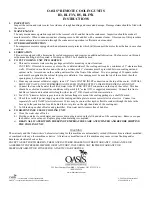
ARIES fr
ee-cooling
GUIDE DE SÉLECTION -
SELECTION GUIDE
12
®
1 Critère de choix
Pour faciliter le choix des unités on a prévu une série de courbes,
graphiques, tableaux que nous décrivons rapidement:
• TABLEAU PERFORMANCES EN RÉFRIGÉRATION;
• TABLEAU PERFORMANCES EN FREE-COOLING;
• DIAGRAMMES PERTES DE CHARGE AVEC FC-OFF ET FC-ON;
• TABLEAU LIMITES DE FONCTIONNEMENT;
• TABLEAUX DE CORRECTION puissances frigorifique absorbée et des
pertes de charge : à utiliser quand les conditions d’utilisation du
refroidisseur sont comprises dans un des cas suivants: présence d’eau
glycolée, d’eau sale (facteurs d’encrassement supérieurs de 5 x 10 - 5
m2 °C/W), installations en localités à des altitudes supérieures à zéro,
∆
T différents du
∆
T nominal.
2 Exemple de choix
Supposons de devoir éliminer une charge thermique dans les conditions
de projet suivantes:
Condition de projet estivales : Pf = 52 kW Puissance frigorifique requise
t
amb
= 35 °C
Caractéristiques de l’installation: t
IN evap
= 15 °C
t
OUT évap
= 10 °C
glycole
évap
= 30 %
fouling
évap
= 0,000043 m2 K/W
3 Sélection modèle et performances
en condition estivales avec free-cooling OFF
La sélection du modèle de ARIES FC doit être effectuée en fonction des
conditions de projet estivales (les plus lourdes). À l’aide des tableaux
“Performances en réfrigération” avec t amb = 35 °C et eau 15/10 °C on
peut déduire que le modèle approprié est le AS 251 FC, configuration N
caractérisé par:
Pf = 54,6 kW
Puissance frigorifique
Pa = 19,3 kW
Puissance absorbée compresseurs
Fw = 10,4 m3/h
Débit eau à l’évaporateur
En tenant aussi compte de l’absorption des ventilateurs, la puissance
totale absorbée est de:
Pa
tot
= 19,3 + 3 x 0,78 = 21,64 kW Puissance totale absorbée
La perte de charge lue par le diagramme PERTE DE CHARGE AVEC
FREE-COOLING OFF est de:
∆
p = 0,4 bar
Note: en conditions différentes des conditions nominales il faut utiliser
les facteurs de correction adaptés.
4 Performances en conditions hivernales
avec free-cooling ON
Dans les graphiques correspondant à l’AS 251 FC reportés ci-dessous,
on peut remarquer:
-FREE-COOLING PARTIEL: en hiver le démarrage du fonctionnement
en modalité free cooling a lieu en cas de:
t
ambiente
≤
13 °C
1
Selection criteria
The following curves, graphs and charts have been prepared to facilita-
te selection of the units:
• COOLING PERFORMANCE TABLE;
• FREE-COOLING PERFORMANCE TABLE;
• PRESSURE LOSS DIAGRAMS WITH FC-OFF AND FC-ON;
• OPERATING LIMITS TABLE;
• CORRECTION TABLES for refrigerating capacity, power absorbed and
pressure loss: to be used when the operating conditions of the cooler
include one of the following factors: presence of glycolated water, foul
water (fouling factors greater than 5 X 10-5 m2 °C/W), installations
located at altitudes above sea level,
∆
T other than the nominal.
2 Selection example
Take into consideration that a thermal load must be disposed of under
the following design conditions:
Summer design conditions: Pf = 52 kW Required cooling capacity
t amb = 35 °C
System characteristics: t IN evap = 15 °C
t OUT evap = 10 °C
glycol evap = 30 %
fouling evap = 0,000043 m2 K/W
3 Model selection and performance
in summer conditions with free-cooling OFF
Selection of the ARIES FC model should be made based on summer
design conditions, which are the most demanding.
Using the “Cooling Performance” tables, with t amb = 35 °C and water
15/10 °C it can be deduced that the most suitable model is AS 251 FC,
configuration N, characterized by:
Pf = 54,6 kW
Cooling capacity
Pa = 19,3 kW
Power absorbed by the compressors
Fw = 10,4 m3/h
Water flow to evaporator
If we also take into account the power absorbed by the fans, the total
power consumption is:
Pa tot = 19,3 + 3 x 0,78 = 21,64 kW Total power absorbed
The pressure loss read by the PRESSURE LOSS WITH FREE-COOLING
OFF diagram is:
∆
p = 0.4 bar
Note: under conditions other than the nominal ones suitable correc-
tion factors must be used.
4 Performance in winter conditions with
free-cooling ON
In the graphs pertaining to AS 251 FC, shown below, it can be noted that:
- PARTIAL FREE-COOLING: in winter, operation in free-cooling mode
starts when:
t ambient
≤
13 °C
Summary of Contents for Aries AS 201 FC
Page 2: ...Cooling your industry optimising your process Cooling conditioning purifying...
Page 45: ...ARIES free cooling 43...
Page 46: ...ARIES free cooling 44...
Page 47: ......















































